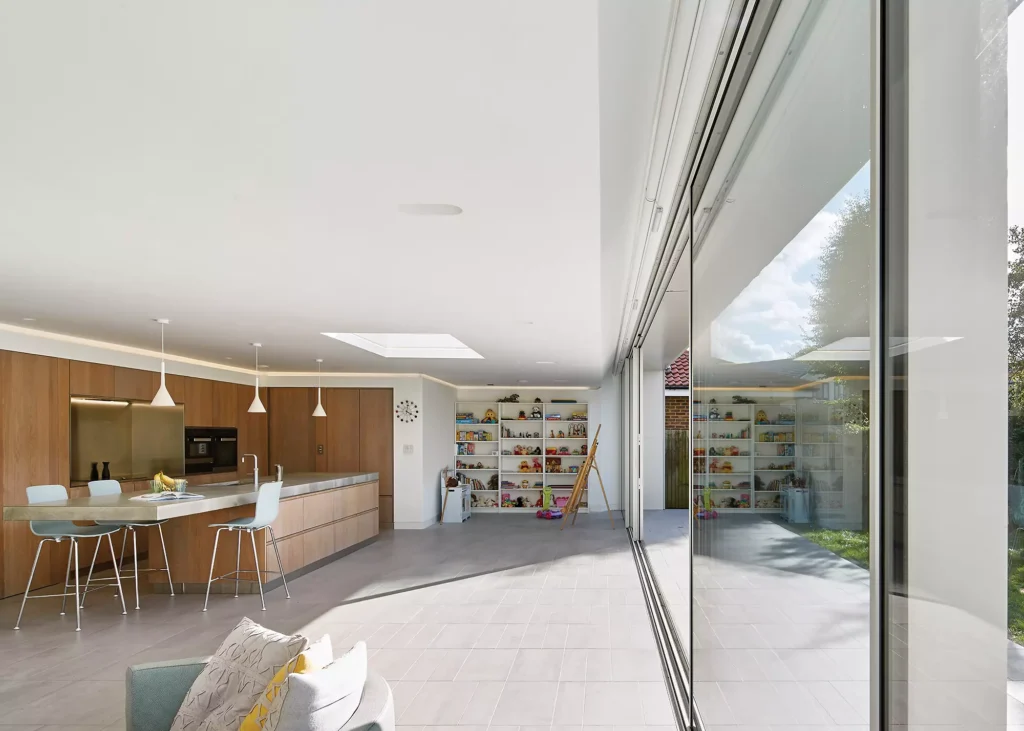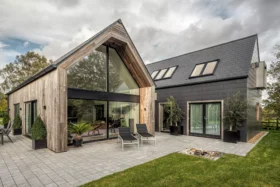
9th & 10th September, Westpoint Arena, Exeter. 100s of suppliers, seminars, expert advice. Explore all the options, all in one place – only at Build It Live.
Book your free tickets now
9th & 10th September, Westpoint Arena, Exeter. 100s of suppliers, seminars, expert advice. Explore all the options, all in one place – only at Build It Live.
Book your free tickets nowLooking for kitchen-diner extension ideas? The main advantage of a new kitchen-diner extension is the new space, whether that’s for day-to-day living or for a multi-purpose area for entertaining and enjoying family time. It will encourage a better connection between the interior and the exterior too. What’s more, it will add value to your home – a typical kitchen-diner can boost sale price by up to 10%.
Many kitchen-diner extensions can be achieved under permitted development (PD) rights. For instance, under PD you can add a single-storey rear extension of up to 4m in depth to a detached house (or up to 8m in England via a prior approval procedure).
Note that PD doesn’t apply to listed buildings or homes located in protected zones, such as conservation areas or areas of outstanding natural beauty. If in doubt, speak to your council. In all cases, Building Regulations approval is necessary to ensure minimum design and construction standards are met for a kitchen-diner extension.
Learn More: 23 Projects You Can Do Without Planning Permission
A single-storey rear addition is often the most straightforward project, and a great option for homes with large gardens that can afford to lose some outside space. Side-return kitchen-diner extensions, where you reclaim the strip of land alongside the building as living space, are also popular – particularly for semi-detached homes.
Wraparound or L-shaped extensions, meanwhile, combine the best of both and can substantially increase the square footage of the property. If you are intending to extend up to a neighbour’s boundary, a separate Party Wall Agreement must be put in place beforehand.
Once you’ve established the type of project that will best suit you, it’s time to set a budget. The price of a small kitchen-diner extension can start from £30,000 but that can rise much higher depending on the size of the project, materials and specification. Make sure you plan the layout upfront, getting plans and quotes from contractors as needed, and be realistic about the cost and timescale.
“The focus is all about planning and creating schedules alongside all trades involved in the development,” says Melissa Klink, Creative Director at Harvey Jones. “Ensure each party understands their role and the timeframe that their work is expected to be carried out in. You should always allow some slack in the programe, and that way you should hopefully not be disappointed if any unforeseen issues arise.”
Before you start your build, think carefully about what you hope to gain from the extra space. The layout should incorporate the practical elements necessary to your lifestyle. Consider surface space, family zones, storage, cupboard heights, task lighting and extraction, for instance.
Materials and colourways will be determined by the ambience you hope to achieve: are you looking for warm and cosy or ultra modern? Can you make use of natural light by installing a roof lantern or glazed doors? And would it make sense to undertake a wider reconfiguration of the downstairs spaces alongside your extension project?
Melissa Klink believes kitchen-diner extensions are so popular due to the don’t move, improve phenomenon. “By extending you can truly make the most out of your beloved home and work with your own style,” she explains.
Increasing the amount usable space while creating a design and layout we love is often much simpler than moving house or starting a new build from scratch. So, although it may be costly and time consuming when you’re in the thick of it, it will all be worth it in the end.
Looking for architects and designers to help with your home extension? Browse Build It’s Company Directory
This charming Arbor kitchen from Harvey Jones features floor-to-ceiling windows to maximise views. The choice to use mainly base cupboards places the focus on the traditional pitched roof, while the island at the centre of the scheme separates the dining area from the kitchen and provides a designated workspace with additional breakfast bar ideal for entertaining.
Storage solutions range from a built-in wine cooler to a customised pantry larder, allowing the space to remain clutter-free. Harvey Jones kitchens start from £25,000.
This 4m2 single-storey extension has replaced an ageing, disjointed PVCu conservatory. Internal gable walls were knocked through to increase space and create a modern kitchen/diner.
A 1m x 2.5m Korniche aluminium roof lantern was chosen to maximise thermal performance while boosting the overhead natural light entering the room.
A Korniche fixed bifold frame with anthracite grey profiles matches the design. Prices start from around £738 for an aluminium roof lantern with clear glazing.
Rixon Architects added side, loft and rear extensions to this split-level terrace to suit the client’s changing growing family. The rear addition houses a modern kitchen-dining-living space, with continuity of materials from inside to out and minimal sliding doors to accentuate the connection between house and garden.
The lower floor was opened to give the family room to socialise, with homogenous polished concrete floors creating a light and airy space. The contract value for this project was £300,000.
More Inspiration: 21 Wow Factor Home Extensions to Inspire your Project
Westbury Garden Rooms’ client wanted a generous kitchen-diner extension full of sunlight and space. The entire rear corner supporting the house was removed to make way for the orangery, with steel beams craned in to support the first floor structure.
Automatic thermostatic air vents in both roof lanterns help to maintain a comfortable temperature through the year – complementing top-hung casement windows and wide French doors. A similar project would cost circa £130,000.
Key considerations for your kitchen diner extensionBecky Palmer, senior designer at Schmidt Wimbledon, shares her top tips for project success:
|
Though there were planning restrictions to the height of this extension, by Paul Archer Design, the feeling of openness has not been compromised.
A main steel beam spans 14.5m across the entire width of the zone. Within are the main family areas comprising a centrally located kitchen with views towards the garden, plus dining, living and play spaces.

Photo: Killian O’Sullivan
A utility and pantry space are concealed behind the kitchen oak-fronted joinery. The island is topped with a polished concrete worktop. This extension project came in at £1,671 per m2.
Read More: Kitchen Worktop Ideas – Granite, Wood, Steel, Laminate & Modern Options
Carefully proportioned windows give this kitchen extension by A2 Studio a sense of height and openness. An oversized pivot door opens into the garden, which can be viewed from a cosy snug through the new oriel window.
Timber is carried through from the window frames and cantilevered canopy lining to the bespoke joinery, providing a warmth that stands nicely against the black brick and reflects the Scandinavian heritage of the client.
Solarlux SL60e aluminium bifold doors were installed by Thames Valley Windows to flood this rear kitchen diner extension with natural light. The units are thermally broken, achieving an overall U-value of 1.4 W/m2k.
Featuring a slimline glass-to-glass measurement of 130mm and an integrated hinge system, the SL60e can also operate with a fully moveable corner post if a completely open-plan effect is desired. From £1,800-£2,160 per panel.
The owners of this terraced home in Shoreditch wanted to increase useable space whilst maintaining the charm of their quirky property. They opted for a pitched roof extension, using IQ Glass structural glazing with steel supports for a modern look.
A double set of slim framed aluminium pivot doors was installed at the end of the space, enabling a fantastic connection between indoors and out. A structurally glazed gable above allows the maximum amount of natural light to flow through the room and provides garden views from all angles.
More Inspiration: Open Plan Living Ideas – Kitchen, Living & Dining Rooms
This single-storey rear extension by GOA Studio opens to the garden through full-height, double glazed bifolds.
Corner glazing and an additional rooflight complete the effect. Supplied by Kitchen Coordination, the retro cabinets are in wood-effect high-gloss laminate, complemented by white quartz worktops. The kitchen cost around £15,000, with the whole project amounting to £150,000 including the extension.
QUICK GUIDE Lighting in kitchen diner extensionsGeorge Omalianakis from GOA Studio, reveals how to use natural and artificial light effectively in your extension:
|
In this scheme by Satish Jassal, 80% of this previously rundown Victorian townhouse was stripped out, restored and replaced.
A two-storey, glass-and-oak rear extension, providing sky views, houses a kitchen-diner downstairs and a fresh new living area above. A steel and oak staircase cantilevers over the kitchen, and the worktops become part of the staircase. The project cost £250,000.
Read More: Budget for Your Extension Project: How Much Will My Extension Cost?
What was once a dark galley kitchen has been transformed into a large, bright extended space full of natural light. CRL Quartz Savannah, with a marble look that ties in well with the stone-effect porcelain tiled floor, was chosen for the worktops.
The surfaces measure 4m along the wall and 2.5m on the island, offering ample food preparation and dining space. Prices for the CRL Quartz Marble collection range from £400 to £650 per m2.
Plus Rooms’ design for this London home combines side and rear extensions with opposing pitched roofs to create the appearance of an acentric gable design from the rear.
A perfect example of how broken plans can create zoning, the rear extension houses a cosy built-in bench, while the side room accommodates the warm and inviting kitchen. Industrial-style doors offer garden views and flood the space with light. A similar project would cost around £86,000.
Constructed with pale buff bricks, this addition by Oliver Leech Architects is formed of two distinct volumes. A side extension provides width to the previously narrow space, with pitched skylights bringing light into the dining space.
A rear extension projects slightly further into the garden, framing a set of Douglas fir bifolds across a low-height window bench
More Inspiration: Brick Design: The Best Brick Ideas for Your Project
